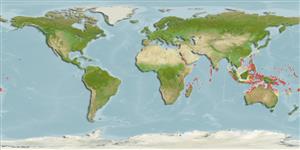Classification / Names
Common names from other countries
Main reference
Size / Weight / Age
Max length : 80.0 cm TL male/unsexed; (Ref. 90102)
Length at first maturity
Lm ?, range 41 - ? cm
Environment
Marine; reef-associated; depth range 1 - 20 m (Ref. 9710)
Climate / Range
Tropical, preferred 28°C (Ref. 107945); 31°N - 25°S, 32°E - 169°W (Ref. 5222)
Distribution
Short description
Dorsal
spines
(total): 7 - 8;
Dorsal
soft rays
(total): 10-12;
Anal
spines: 3;
Anal
soft rays: 8. Distinguished by the following characteristics: Has truncate tail with a narrow white posterior margin (Ref. 37816); further characterized by whitish to pale grey color; head, body and fins with numerous small, dark-edged blue spots; frequently with 4-5 dark blotches forming saddles on back; large canine teeth at front of jaws; 1-4 large canines on side of lower jaw; elongate body, greatest depth 2.9-3.9 in SL; truncate to slightly emarginate caudal fin; pectoral fins 2.0-2.3 in head length; pelvic fins 2.0-2.4 in head length (Ref. 90102); snout length 2.8-3.6 times in head length; suborbital depth 5.6-10 times in HL; flat interorbital area, with small, embedded scales; broadly rounded preopercle, with 3 large , ventrally directed spines along lower half; smooth interopercle and subopercle; 3 flat spines on opercle, upper and lower spines covered by skin; posterior and anterior nostrils subequal in size, set in shallow groove running forward from eye (Ref. 89707).
IUCN Red List Status (Ref. 115185)
Threat to humans
Reports of ciguatera poisoning (Ref. 4690)
Human uses
Fisheries: minor commercial
More information
ReferencesAquacultureAquaculture profileStrainsGeneticsAllele frequenciesHeritabilityDiseasesProcessingMass conversion
Tools
Special reports
Download XML
Internet sources
Estimates of some properties based on models
Phylogenetic diversity index
PD50 = 0.5078 many relatives (e.g. carps) 0.5 - 2.0 few relatives (e.g. lungfishes)
Trophic Level
4.5 ±0.80 se; Based on food items.
Resilience
Low, minimum population doubling time 4.5 - 14 years (Preliminary K or Fecundity.)
Vulnerability
High vulnerability (57 of 100)
Price category
